Sri Lanka is one of the neighbouring countries of India. Sri Lanka has a special place in Indian hearts, given the time-tested bonds, going back almost to the very beginning of recorded history in the subcontinent. The relationship between India and Sri Lanka is more than 2,500 years old, and both sides have built upon a legacy of intellectual, cultural, religious and linguistic interaction. In recent years, the relationship has been marked by close contacts at the highest political level, growing trade and investment , cooperation in the fields of development, education, culture and defence, as well as a broad understanding on major issues of international interest.
Bilateral exchanges at various levels over the past year and significant progress in implementation of developmental assistance projects for the Internally Displaced Persons (IDPs) and disadvantaged sections of the population in Sri Lanka has helped further cement the bonds of friendship between the two countries.
The nearly three-decade long armed conflict between Sri Lankan forces and the Liberation Tigers of Tamil Eelam (LTTE) came to an end in May 2009. During the course of the conflict, India supported the right of the Government of Sri Lanka to act against terrorist forces. At the same time, it conveyed at the highest levels, its deep concern at the plight of the mostly Tamil civilian population, emphasizing that their rights and welfare should not get enmeshed in hostilities against the LTTE.
The need for national reconciliation through a political settlement of the ethnic issue has been reiterated by India at the highest levels. India’s consistent position is in favour of a negotiated political settlement, which is acceptable to all communities within the framework of a united Sri Lanka, and which is consistent with democracy, pluralism and respect for human rights.
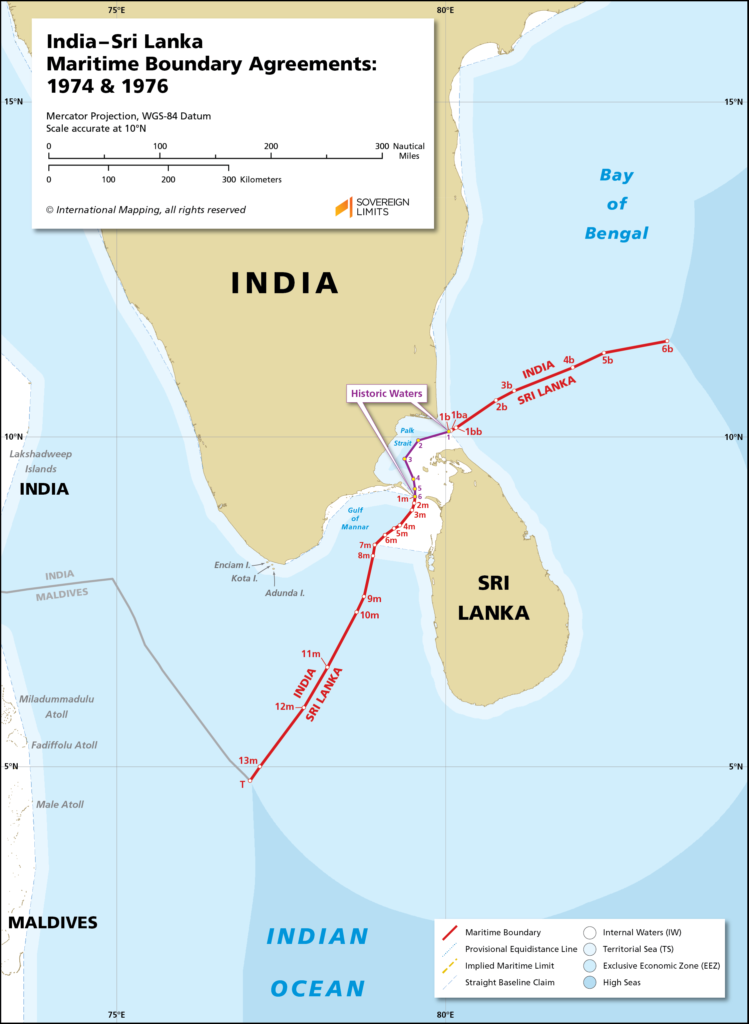
Historical Relations
Pre-Independence Relations
- The earliest mention of Sri Lanka dates back to the time of the Ramayana. Ravana, who held Sita captive in Lanka, was rescued by Ram with the help of Hanuman.
- The relations go back to the times of the advent of Buddhism. Buddhism as a movement spread over Sri Lanka some 2000 years ago.
- The north and north east region of Lanka has been economically integrated to India.
- The native people of Sri Lanka (then Ceylon) were colonially under the British, but were not a part of British India Empire, being administered separately.
- From the 1830s onwards, British acquired indentured labour from India, especially from Tamil Nadu, to Ceylon. The Tamils who were transported by the British settled in the northern part of Ceylon.
Post-Independence Relations
- India became independent in 1947 while Ceylon in 1948.
- After Ceylon became independent, the Sinhalese government discriminated against Tamils, thereby deepening the void in Indo–Ceylon relations.
- Ceylon, devised a mechanism to make it tough for Tamils to acquire state citizenship. They also wanted to ensure they put an end to Tamil dominance in public services. Through the Sinhalese language barrier, they made it tough for Tamil administrators.
- However, in 1964, there was a Shastri–Sirimavo pact that was signed whereby Ceylon agreed to give three lakh Indian Tamils in Ceylon citizenship and India also agreed to repatriate a sizeable number to India. However, the matter of repatriation did not complete till 1988.
- After the 1971 Indo–Pak war, Indian allegiance shifted towards the USSR as Sri Lanka gradually drifted towards the US.
- Jayewardene advanced a liberal and open economy and positioned Sri Lanka westward.
- The situation especially deteriorated in 1977 and 1981 due to Tamil riots.
- Post 1980, India adopted a very delicate policy. It is widely alleged by scholars and theorists that India used the Research & Analysis Wing (R&AW) to train Tamil rebels in Sri Lanka. The aim was to use Tamil rebels to destabilise the Jayewardene regime and also while also ensuring that the Tamil rebels do not succeed in creating a separate state.
- It was in 1976 that the Liberation of Tamil Tigers Eelam (LTTE), a separatist and insurgent militant force, was formed by V Prabhakaran.
- As the R&AW had gradually succeeded in destabilizing the Sri Lankan government, it slowly stopped supporting the rebels.
- But by this time, the LTTE had emerged as a powerful force and began to assert itself as the sole representative of Tamils in Sri Lanka.
- When Indira Gandhi died, Jayewardene took the help of Pakistan and the US to get Sri Lankan forces trained to counter the LTTE rebels.
- In 1987, Jayewardene formally requested India to oppose any kind of military intervention by the LTTE in Sri Lanka but India failed to act
- India–Sri Lanka Accord (ISLA) had been signed on 29 July 1987, which assigned a certain amount of autonomy to Tamil areas.
- Sinhalese began to perceive India’s role as an undue interference in Sinhalese internal affairs that was not in Sri Lanka’s best interests.
- In November 1989, in the Indian elections, V P Singh won and in March 1990, it ended the IPKF mission. The IPKF was recalled to India. In 1991, the LTTE assassinated Rajiv Gandhi and then was subsequently designated as a terrorist organisation.
- After the death of Rajiv Gandhi, many Tamil groups also began to stop supporting the LTTE. As India realised the failure of its mission, it also felt the need to go for a fresh look at India’s Sri Lanka policy.
Post Cold War Period Relations
- As the Cold War ended, India opened up its economy and gave itself a fresh outlook to explore relations with the outside world.
- This did impact our perception of Sri Lanka. Even the subsequent heads of state of Sri Lanka, namely, Kumaratunga and Wickremesinghe, took steps to improve relations.
- In 1998, India–Sri Lanka Free Trade Agreement was signed.
- From 2000 till 2003, India, encouraged dialogue and ceasefire between Sri Lanka and the LTTE, without being formally involved in the process.
- Rajapaksa became President in November 2005. The period from 2005 to 2006 saw civil unrest in Lanka. The government of Rajapaksa increased the military backlash and launched Eelam war–IV from 2006 to 2009.
- Prabhakaran, the most prominent leader of the LTTE, was killed in 2007 and by May 2009, the LTTE was wiped out.
- During the Eelam war–IV, as India stayed out, Sri Lanka developed proximity with Pakistan and China.
- Th post-LTTE period witnessed rising concern on the part of India as Pakistani pilots supplied training and ornament to Sri Lanka. Arms were also provided by China, along with substantial economic aid. China was granted access to the Hambantota port, which India had earlier declined to develop citing financial reasons.
- This has increased Indian fears as the possibility of a civilian–military nexus in Sri Lanka could endanger Indian security.
- The major focus of India now is to ensure that Pakistan and China don’t use Sri Lanka against India.
Geopolitical Significance of Sri Lanka
- Sri Lanka located at the southern tip of peninsular India is strategically important for India in the most comprehensive sense.
- The strategic importance of Sri Lanka was well realized by Britain for the security of both British India and the Indian Ocean and they developed a major naval base at Trincomolee on the eastern coast.
- This island nation lies astride the major sea lanes of communication from Europe to East Asia and the oil tanker routes from the oil producing countries of the Gulf to China, Japan and other Pacific countries.
- In the military sense it is important to the United States as these same sea routes are used for transference of naval power from the Pacific Ocean to the Indian Ocean and the Gulf.
- Some examples that highlight Western interests in Sri Lanka’s strategic location are the British Defence and External Affairs Agreement of 1948, and the Maritime Agreement with USSR of 1962.
- Even during the J.R Jayewardene (1978-1989) and Ranasinghe Premadasa (1989-1993) tenures, Sri Lanka was chosen to build the Voice of America transmitting station (suspected of being used for intelligence gathering purposes and electronic surveillance of the Indian Ocean).
- It was the massive Chinese involvement during the Rajapaksa tenure that garnered the deepest controversy in recent years.
- China is building state of the art gigantic modern ports all along the Indian Ocean to the south of it, in Gwadar (Pakistan), Chittagong (Bangladesh, Kyauk Phru (Myanmar) and Hambantota (Sri Lanka).
- China’s string of pearl’s strategy is aimed at encircling India to establish dominance in the Indian Ocean.
- Post 2015, Sri Lanka still relies heavily on China for Port city project and for continuation of Chinese funded infrastructure projects in Sri Lanka.
- Although the Hambantota harbour is reportedly making losses, it too has potential for development due to its strategic location.
- Sri Lanka has a list of highly strategic ports located among busiest sea lanes of communication. Sri Lanka’s Colombo Port is the 25th busiest container port in the world and the natural deep water harbor at Trincomalee is the fifth largest natural harbour in the world.
- Port city of Trincomalee was the main base for Eastern Fleet and British Royal Navy during the Second World War. Sri Lanka’s location can thus serve both commercial and industrial purposes and be used as a military base.
- India too has a vital strategic stake in Sri Lanka for her own security interests. An unfriendly Sri Lanka would strategically discomfit India. Sri Lanka is also strategically important to India in terms of her Indian Ocean strategy and in terms of networking of partners for her aims of establishing an Indian Ocean Rim Community.
- For the Indian Navy, it is important as the switching of naval fleets from the Bay of Bengal to the Arabian Sea and vice versa the fleets have to take a round of Sri Lanka.
Areas of Cooperation b/w India-Sri Lanka
Political
- Political relations between the two countries have been marked by high-level exchanges of visits at regular intervals.
- Historically, bilateral ties have been fraught with controversies. In the 1980s, the Tamil question dominated relations and more recently, differences have sometimes erupted over poaching by fishermen and Sri Lanka’s increasing dependence on China for investment.
- President Maithripala Sirisena visited India in February 2015 and May 2016 on working visits. During the visit, he visited New Delhi, Ujjain and Sanchi. President Maithripala Sirisena also travelled to India on 15-17 October 2016 to attend the BRICS-BIMSTEC Outreach Summit.
- Prime Minister Ranil Wickremesinghe visited India in September 2015, his first overseas visit after being appointed as Prime Minister. Most recently, PM Ranil Wickremesinghe visited India from 18-20 October 2018.
- In June 2019, the first overseas visit of Indian Prime Minister to Sri Lanka, in his second term, is an important symbolic gesture reflective of the special relationship between the countries.
- Sri Lanka is a member of regional groupings like BIMSTEC (Bay of Bengal Initiative for Multi-Sectoral Technical and Economic Cooperation) and SAARC in which India plays a leading role.
- Recently, India has invited leaders of BIMSTEC member countries to attend the swearing-in of Prime Minister Narendra Modi and his council of ministers. This is in line with the government’s focus on its ‘Neighbourhood First’ policy.
- Sri Lanka has long been in India’s geopolitical orbit, but its relationship with China has strengthened in recent years.
- Former President Rajapaksa took Sri Lanka closer to China and sidelining Indian concerns including over the rehabilitation of Tamils displaced by the long-running Sri Lankan civil war.
Commercial
- Sri Lanka is one of India’s largest trading partners in SAARC, while India is Sri Lanka’s largest trade partner globally.
- Trade between the two countries grew rapidly particularly after the entry into force of the India-Sri Lanka Free Trade Agreement in March 2000.
- India is among the top four investors in Sri Lanka with cumulative investments of over US$ 1 billion since 2003. The investments are in diverse areas including petroleum retail, IT, financial services, real estate, telecommunication, hospitality & tourism, banking and food processing (tea & fruit juices), metal industries, tires, cement, glass manufacturing, and infrastructure development (railway, power, water supply).
- India is also one of the largest contributors to Foreign Direct Investment in Sri Lanka. A number of leading companies from India have invested and established their presence in Sri Lanka.
- According to BoI, FDI from India amounted to about US$ 1.7 billion during the period 2005 to 2019.
- Bilateral trade in 2016 amounted to US $ 4.38 billion. Exports from India to Sri Lanka in 2016 were US$ 3.83 billion, while exports from Sri Lanka to India were US$ 551 million.
- In 2020, India was Sri Lanka’s 2nd largest trading partner with the bilateral merchandise trade amounting to about USD $ 3.6 billion.
- Sri Lankan exports to India have increased substantially since 2000 when ISLFTA came into force and more than 60% of Sri Lanka’s total exports to India over the past few years have used the ISFTA benefits.
- Interestingly, only about 5% of India’s total exports to Sri Lanka in the past few years have used the ISFTA provisions, thereby indicating their overall competitiveness in the Sri Lankan market.
Developmental Cooperation
Sri Lanka is one of India’s major development partners and this partnership has been an important pillar of bilateral ties between the two countries over the years. With grants alone amounting to around USD 570 million, the overall commitment by GOI is to the tune of more than USD 3.5 billion. India’s portfolio of development projects encompasses virtually all major sectors of the economy, including housing, infrastructure, education, health, agriculture, fisheries, industry, handicrafts, culture and sports.
The Government of India has put in place a robust programme of assistance to help the Internally Displaced Person (Persons affected by the LTTE war and displaced Tamilians due to humanitarian crisis) return to normal life as soon as possible. The main impetus for stepping up of India’s development assistance flowed from the commitments made during the visit of President of Sri Lanka to India during June 2010. These included:
- Construction of 50,000 housing units,
- Rehabilitation of the Northern Railway lines,
- Wreck-removal,
- Establishment of Vocational Training Centres,
- Construction of a Cultural Centre at Jaffna, restoration of Thiruketheeswaram Temple,
- Establishing an Agricultural Research Institute in the Northern Province,
- Expanding the scholarship program for Sri Lankan students to pursue their higher studies in India,
- Setting up Centres for English Language Training and Providing technical assistance for the National Action Plan for a Trilingual Sri Lanka.
- The Housing Project, with an overall commitment of over INR 1372 crore in grants, is the flagship project of Government of India’s assistance to Sri Lanka. Sri Lanka is one of the major recipients of development credit given by the Government of India, with total commitment of US $2.63 billion, including US $ 458 million as grants.
- India also continues to assist a large number of smaller development projects in areas like education, health, transport connectivity, small and medium enterprise development and training in many parts of the country through its grant funding.
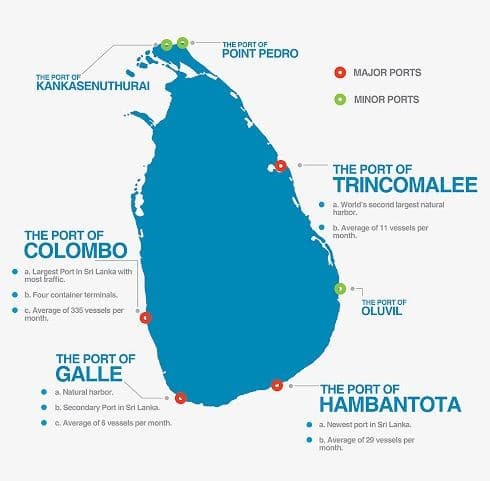
India & Japan are allowed to build a new container terminal
- Sri Lanka’s government said, it will allow India and Japan to develop a new container terminal at the country’s main port, several weeks after scrapping a deal with the two countries to develop one of the key terminals at the same port.
- Sri Lanka halted the 2019 agreement for India and Japan to develop and operate the crucial East Container Terminal at Colombo Port after weeks of protests by trade unions and opposition parties.
- India has selected Adani ports, which was earlier chosen to invest in the East Container Terminal. Which will be operated on a build, operate and transfer basis for 35 years.
China’s angle to the move
- India, which considers the Indian ocean region to be its strategic backyard, has worried by rival China’s growing economic and political influence over neighbouring Sri Lanka.
- China considers Sri Lanka to be a critical link in its massive “Belt and Road” global infrastructure building initiative and has provided billions of dollars in loans for Sri Lankan projects over the past decade. The projects include a seaport, airport, port city, highways and power stations.
- China already operates the Colombo International Container Terminal as a joint venture with the Ports Authority.
- Critics say the Chinese-funded projects are not financially viable and that Sri Lanka will face difficulty in repaying the loans.
- In 2017, Sri Lanka leased a Chinese-built port located near busy shipping routes to a Chinese company for 99 years to end the heavy burden of repaying the Chinese loan used to build it.
- Japan and India are members of Quad, a group of Indo-Pacific nations that also includes the US and Australia that is seeking to counter Chinese influence in the region
Defence and Security Cooperation
- Sri Lanka and New Delhi have long history of security cooperation. In recent years, the two sides have steadily increased their military-to-military relationship.
- India and Sri Lanka conducts joint Military ( ‘Mitra Shakti’) and Naval exercise (SLINEX).
- India also provides defence training to Sri Lankan forces.
- A trilateral maritime security cooperation agreement was signed by India, Sri Lanka and the Maldives to improve surveillance, anti-piracy operations and reducing maritime pollution in Indian Ocean Region.
- In April 2019, India and Sri Lanka also concluded agreement on countering Drug and Human trafficking.
- In the aftermath of the horrific Easter bombings, Sri Lankan Prime Minister thanked the Indian government for all the “help” given.
- The alerts issued by Indian agencies before the attacks had warned specifically about the use of radicalised suicide bombers attacking churches and the Indian High Commission in Colombo.
- The Colombo Security Conclave has been formed in 2011 as a trilateral Indian Ocean maritime security grouping of India, Sri Lanka and the Maldives.
Cultural
- The Cultural Cooperation Agreement signed by the Government of India and the Government of Sri Lanka on 29 November, 1977 at New Delhi forms the basis for periodic Cultural Exchange Programmes between the two countries. The Indian Cultural Centre in Colombo actively promotes awareness of Indian culture by offering classes in Indian music, dance, Hindi and Yoga.
- Every year, cultural troupes from both countries exchange visits. Pursuant to an announcement made by the Prime Minister during his visit to Sri Lanka, a Festival of India in Sri Lanka was launched in November 2015, with ‘Nrityarupa’ (a scintillating dance medley from different parts of India performed in Colombo, Kandy and Galle). The theme of the Festival was ‘Sangam’: a confluence of cultures of India and Sri Lanka.
- The India-Sri Lanka Foundation, set up in December 1998 as an intergovernmental initiative, also aims towards enhancement of scientific, technical, educational and cultural cooperation through civil society exchanges, and enhancing contact between the younger generations of the two countries.
- Education is an important area of cooperation. India now offers about 290 scholarship slots annually to Sri Lankan students.
- In addition, under the Indian Technical and Economic Cooperation Scheme and the Colombo Plan, India offers 370 slots annually to Sri Lankan nationals.
People to People Contact
The People of Indian Origin (PIOs) comprise Sindhis, Borahs, Gujaratis, Memons, Parsis, Malayalis and Telugu speaking persons who have settled down in Sri Lanka (most of them after partition) and are engaged in various business ventures. Though their numbers (10,000 approximately) are much lesser as compared to Indian Origin Tamils (lOTs), they are economically prosperous and are well placed. Each of these communities has their organization which organizes festivals and cultural events.
Areas of cooperation for mutual benefits in India-Sri Lanka Relations:
- In the Energy sector, India and Sri Lanka have agreed to jointly revive a World War II era oil storage facility in the strategically located eastern port town, and build infrastructure around it.
- There exists considerable private sector investment opportunities in both the countries. The major areas of cooperation between both the countries are petroleum, Information Technology, Financial Services, Real estate, telecom, hospitals, tourism, banking, food processing, etc.
- Indian railways are offering special package for Sri Lankan tourists to come to India. India has also introduced e-visa for Sri Lanka.
- India is pushing for a new trade pact called the Economic and Technical cooperation Agreement (ETCA) to build closer ties with Sri Lanka. It will replace the CEPA and establish an agreement on trade in services and technological exchange. ETCA will boost standard of goods and services, and will be able to compete on global market and improve opportunities for manpower training and human resource development.
Significance of Sri Lanka for India:
- Sri Lanka is India’s closest maritime neighbour and is strategically located in Indian Ocean and Bay of Bengal.
- As per its ‘Neighbourhood-First Policy’ and the ‘SAGAR (Security and Growth for All in the Region) Doctrine’, India attaches great importance to Sri Lanka “to keep the Indian Ocean region peaceful and secure”.
- 70% of Indian cargo comes through the Colombo port, which is a largest trans-shipment port of South-Asia.
Major issues b/w India-Sri Lanka
Fishermen & Katchatheevu Island Issue:
A maritime dispute between India and Sri Lanka remains unsolved, despite an agreement 47 years ago. Notwithstanding the 1974 Indo-Lanka Maritime Boundary Agreement, Indian fishermen tend to cross the maritime border into Sri Lanka in the Palk Strait, which in turn leads to assaults by the Sri Lankan Navy. The fishermen were beaten to death by Sri Lankan naval officers.
- Given the proximity of the territorial waters of both countries, especially in the Palk Straits and the Gulf of Mannar, incidents of straying of fishermen are common.
- Indian boats have been fishing in the troubled waters for centuries and had a free run of the Bay of Bengal, Palk Bay and the Gulf of Mannar until 1974 and 1976 when treaties were signed between the two countries to demarcate International Maritime Boundary Line (IMBL).
- However, the treaties failed to factor in the hardship of thousands of traditional fishermen who were forced to restrict themselves to a meagre area in their fishing forays.
- The small islet of Katchatheevu, hitherto used by them for sorting their catch and drying their nets, fell on the other side of the IMBL.
- Fishermen often risk their lives and cross the IMBL rather than return empty-handed, but the Sri Lankan Navy is on alert, and have either arrested or destroyed fishing nets and vessels of those who have crossed the line.
- Both countries have agreed on certain practical arrangements to deal with the issue of bona fide fishermen of either side crossing the International Maritime Boundary Line.
- Through these arrangements, it has been possible to deal with the issue of detention of fishermen in a humane manner.
- India and Sri Lanka have agreed to set up a Joint Working Group (JWG) on Fisheries between the Ministry of Agriculture and Farmers Welfare of India and Ministry of Fisheries and Aquatic Resources Development of Sri Lanka as the mechanism to help find a permanent solution to the fishermen issue.
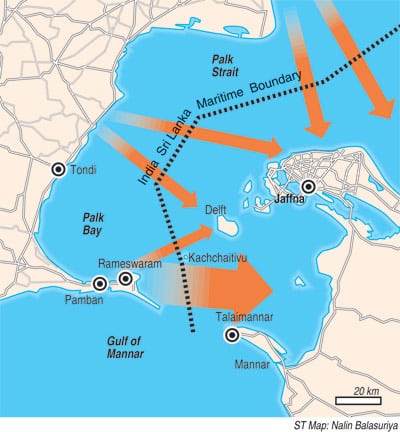
Katchatheevu Island:
- Kachchatheevu is a small island located about 10 miles north east of Rameshwaram. The island of Katchatheevu was ceded to Sri Lanka in 1974 when India and Sri Lanka demarcated their international maritime boundary line (IMBL).
- Indian fishermen continue to get caught fishing off Katchatheevu on the premise that it’s a ‘traditional’ fishing ground. But this is contested not only by fishermen of Sri Lanka but also its Navy. To resolve the issue, both countries have agreed on certain arrangements (Joint Working Group) to deal with the issue of fishermen.
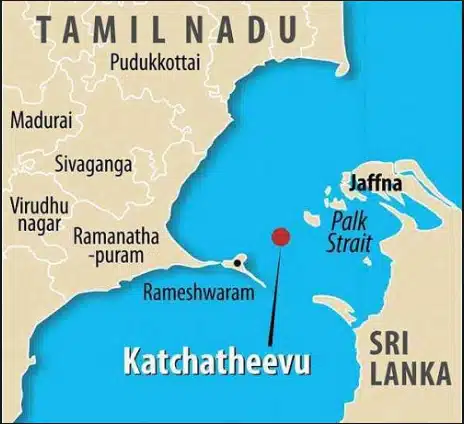
Political Turmoil:
- On 25 October 2018, Sri Lanka’s President Maithripala Sirisena sacked Prime Minister Ranil Wickramasinghe and replaced him with Mahinda Rajapaksa, the former president. New Delhi responded to this crisis by calling for the constitutional process to be respected and extending its developmental assistance to Sri Lanka. On the other hand, Chinese ambassador in Colombo was very quick to congratulate Rajapaksa.
China’s influence in Sri Lanka:
- China has been making huge amount of investments in Sri Lanka. Colombo City Project, Hambantota Port, anchoring of Chinese warship and submarines raises concern in India on growing influence of China in the country as well as the Indian Ocean region.
- Few years ago, Sri Lanka could no longer afford its payments for the debt taken from China and so, Beijing pressured Sri Lanka to deliver the new port directly into Chinese hands. This resulted in China gaining a controlling equity stake and a 99 year lease for Hambantota port in December 2017.
- According to the 2018 annual report of the Central Bank of Sri Lanka, imports from China accounted for 18.5%, just a little less than the 19% from India.
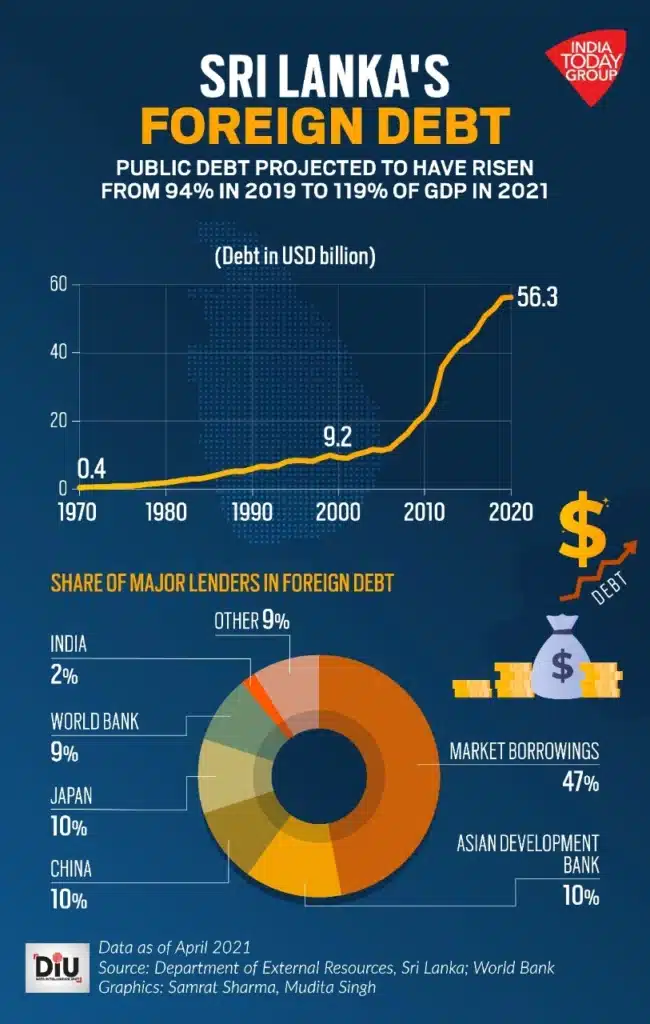
Tamil Issue:
India has stressed on a meaningful devolution package based on the 13th Amendment. India’s interest is not only cultural but also demographic as around 1 lakh Tamil refugees are living in India. Until a political reconciliation is achieved in Sri Lanka, return of these refugees will not be possible.
Peace Accord: In 1987, Indian Prime Minister Rajiv Gandhi and Sri Lankan President J. R. Jayewardene signed the Indo-Sri Lanka Peace Accord to resolve the civil war. Under the terms of the agreement, while Colombo had to devolve power to the provinces (so that provinces get significant autonomy, including northern provinces), LTTE had to surrender the arms. The provisions for setting up of a Provincial Council for each Province; establishment of a High Court for each Province; and making Tamil an official language and English as the link language was to be achieved via the 13th amendment of the Constitution of Sri Lanka.
Economic and Technological Cooperation Agreement (ETCA):
India and Sri Lanka entered into free trade agreement in 2000. To deepen the economic relation further, both countries started to negotiate Comprehensive Economic Partnership Agreement (CEPA) as CEPA would have liberalized trade in services and investment. India is pushing for a new trade pact called the Economic and Technological Cooperation Agreement (ETCA) which is an extension of existing FTA. While India is looking at the ETCA as a mechanism to enable it to participate in the post-war economic development of Sri Lanka through Indian investments in select areas, the Sri Lankan government is wanting to use ETCA to become part of the Indian supply chain, exploiting India’s “Make in India” movement. It is a win-win situation for all. Also, India has assured that it will not thrust anything on Sri Lanka. Indian Prime Minister has said twice that Indian economic cooperation will be based on Sri Lanka’s needs and priorities.
- Objectives: The ETCA agreement seeks to boost cooperation in technical areas, scientific expertise and research amongst institutions, boost standards of goods and services to make them able to compete on the global market, and improve opportunities for manpower training and human resource development.
- Issues: The progress on ETCA has been discouraging, however, and some have doubted the benefits of the agreement. Sri Lanka’s Joint Opposition has said the agreement was an appeasement ‘ of India, ignoring the greater largesse from China.
Conclusion
- As a prominent Asian nation with critical national interests in South Asia, India has a special responsibility to ensure peace and stability in its closest neighbourhood. India needs the support of Sri Lanka to emerge as a Blue water navy in the Indian Ocean and also in pursuing the permanent membership in United Nations Security Council (UNSC).
- As both countries have a democratic setup there is scope for broadening and deepening the ties.
- Both countries should try to work out a permanent solution to the issue of fishermen through bilateral engagements.
- Comprehensive Economic Partnership Agreement (CEPA) must be signed to improve the economic cooperation between both countries .
- India needs to focus more on its traditional and cultural ties to improve relations with Sri Lanka.
- Starting of ferry services between India and Sri Lanka can improve people to people linkages.
- Mutual recognition of each other’s concerns and interests can improve the relationship between both countries.
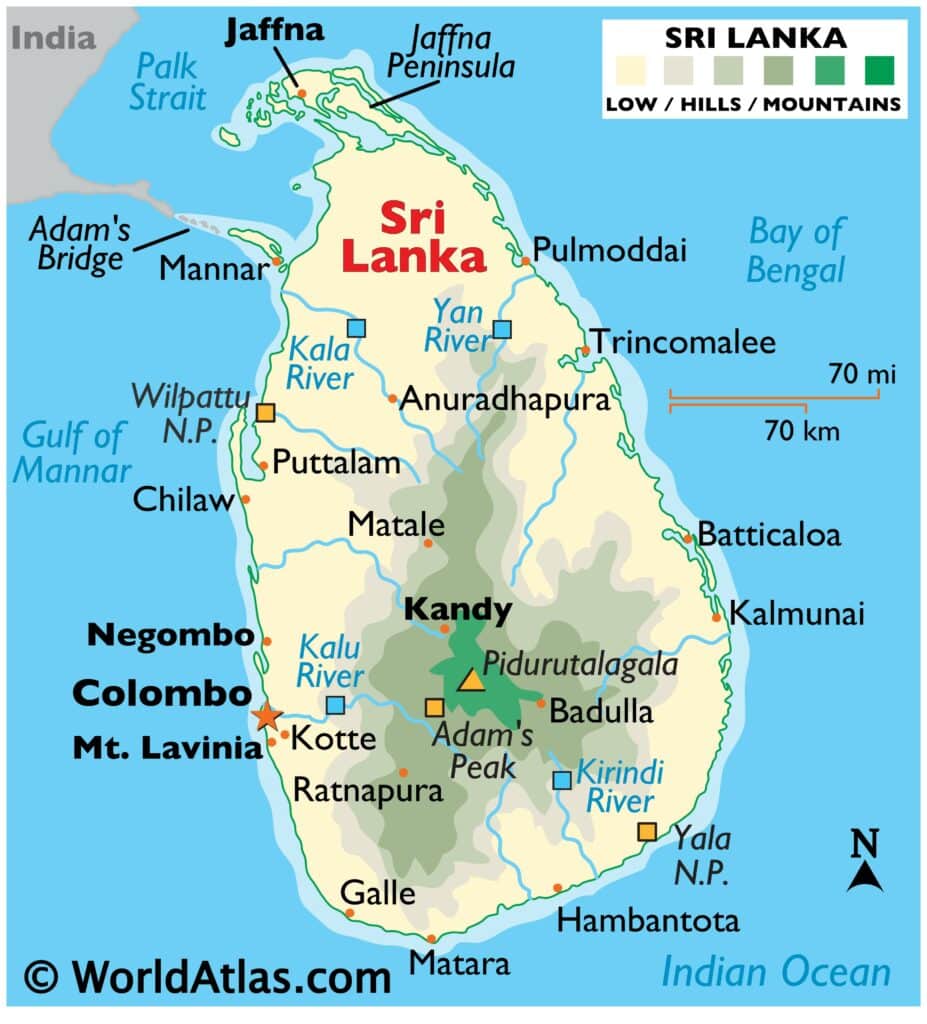

Nicely explained